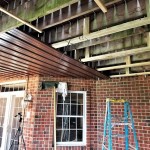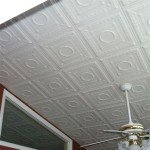How Deep Should A Coffered Ceiling Be?
Coffered ceilings, with their intricate gridwork of recessed panels, are a captivating architectural detail that adds a touch of elegance and sophistication to any space. These ceilings, often found in historic buildings and grand homes, create a sense of depth and visual interest. When designing a coffered ceiling, one crucial factor to consider is the depth of the coffers. The depth of the coffers significantly impacts the overall aesthetic, functionality, and even the cost of the project. Striking the right balance between aesthetics and practicality is key for achieving a stunning and functional coffered ceiling.
Factors Influencing Coffer Depth
The optimal depth of coffered ceilings depends on a variety of factors, including the size and scale of the room, the desired aesthetic, and the type of materials used. Here are some key considerations:
Room Size and Scale
The size of the room plays a crucial role in determining the appropriate coffer depth. In large, high-ceilinged spaces, deeper coffers can create a more dramatic and impressive effect. They provide ample space for intricate details and decorative elements, enhancing the grandeur of the room. In smaller rooms, shallower coffers are generally preferred. Deep coffers in cramped spaces can overwhelm the room, making it feel even smaller. The goal is to achieve a balanced and harmonious visual effect.
Desired Aesthetic
The aesthetic you're aiming for also influences the coffer depth. For a more traditional or formal look, deeper coffers with intricate moldings and embellishments are ideal. They create a sense of weight and formality, reminiscent of classic architecture. On the other hand, shallower coffers with simpler designs can achieve a contemporary or minimalist aesthetic, emphasizing clean lines and modern simplicity.
Material Selection
The material used for the coffers also impacts the depth. Heavier materials like wood require a deeper coffer to accommodate their thickness and weight. Lighter materials like plaster or drywall allow for shallower coffers. It's essential to consider the structural integrity of the materials and ensure the coffers are adequately supported.
Aesthetic Considerations
The depth of the coffers significantly impacts the visual appeal of the ceiling. Deeper coffers create a more pronounced sense of depth and dimension. They enhance the three-dimensional quality of the ceiling, adding a layer of complexity and visual interest. They also offer a larger surface area for decorative elements, allowing for greater visual impact.
Light and Shadows
Coffer depth influences how light interacts with the ceiling. Deeper coffers cast more dramatic shadows, creating a sense of depth and intrigue. They can highlight the intricacies of the design, adding a touch of drama to the space. Conversely, shallower coffers create softer shadows, resulting in a more subtle and refined aesthetic. The choice between these two approaches depends on the desired mood and atmosphere.
Visual Balance
The depth of the coffers should be proportionate to other architectural features in the room. If the room boasts high ceilings and grand proportions, deeper coffers can amplify the sense of scale. In rooms with lower ceilings and a more intimate atmosphere, shallower coffers can help maintain a sense of balance and avoid overwhelming the space.
Practical Concerns
Beyond aesthetics, the depth of the coffers also has practical implications. Deeper coffers can impact the headroom of the space, particularly in rooms with lower ceilings. In such cases, shallow coffers are recommended to minimize the impact on headroom. The depth of the coffers also influences the cost of construction, materials, and labor. Deeper coffers generally require more materials and labor, contributing to higher project costs.
Recommended Depth Ranges
While there is no fixed rule for coffer depth, general guidelines can help you determine a suitable range for your project. Here's a suggested breakdown:
Traditional and Formal Styles:
For a traditional or formal aesthetic, a deeper coffer depth of 6-12 inches is commonly used. This range allows for intricate moldings, decorative elements, and bold shadow play.
Contemporary and Minimalist Styles:
For contemporary or minimalist styles, a shallower coffer depth of 3-6 inches is often preferred. This range maintains a sleek and clean aesthetic, emphasizing clean lines and subtle shadows.
Small Rooms:
In small rooms, a coffer depth of 3-4 inches is generally recommended to avoid overwhelming the space.
Large Rooms:
In large rooms, a coffer depth of 6-8 inches can enhance the sense of scale and grandeur.
Ultimately, the best coffer depth is a matter of personal preference and the overall design aesthetic you're trying to achieve. By considering the factors outlined above, you can make an informed decision that suits your needs and preferences, creating a stunning and functional coffered ceiling that elevates the ambiance of your space.

Coffered Ceiling Diy Step By Install Guide Arched Manor

5 Things You Need To Know About Coffered Ceilings Intrim Mouldings

Coffered Ceiling Inspiration Socaltrim Discount Molding Millwork

Coffered Ceiling Layout Thisiscarpentry

Handyman Hints Creating The Coffered Ceiling Cornwall Standard Freeholder

Coffered Ceiling Help 14 Wide Beams How Deep

Coffered Ceilings 101 Scott Mcgillivray

Coffered Ceiling Diy Step By Install Guide Arched Manor

Coffered Ceiling Ceilings Armstrong Residential

How To Build A Diy Coffered Ceiling Step By Our Aesthetic Abode
Related Posts








